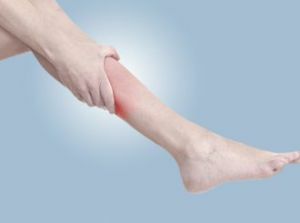 The appearance of blood clots in the legs is considered quite a dangerous violation, which often has an asymptomatic course, but at the same time, if the treatment of the disease is not started in time, there is a risk of dangerous consequences.
The appearance of blood clots in the legs is considered quite a dangerous violation, which often has an asymptomatic course, but at the same time, if the treatment of the disease is not started in time, there is a risk of dangerous consequences.
Thrombosis is often accompanied by the formation of blood clots in the blood vessels, which disrupts blood circulation.
After some time they can block the venous lumen or come off. This leads to the death of tissue and the entry of a blood clot into the heart, lungs or other organs. This condition is fraught with the development of a stroke, thromboembolism or a heart attack. These diseases often cause paralysis and even death.
Contents
- Causes and mechanism of development of the disorder
- Varieties of blood embryos
- Clinical picture
- Diagnosis
- Treatment methods
- Hidden and obvious dangers
- Prevention of thrombosis
Causes and mechanism of development of the disorder
This pathology is a consequence of a clotting disorder and the work of an anticoagulant system. At the same time, condensation is observed and blood clotting increases.
Clots, as a rule, appear in the area of damage to the vascular walls or in the zone of localization of atherosclerotic plaques. Then, microinflammation develops and fibrin strands are deposited. This causes the appearance of a primary clot.
Clotting of thrombotic masses leads to clot growth. Then there is a rupture of the thrombus and blood flow stops. This situation can lead to death.
To the formation of thrombi in the legs lead such factors:
- damage to the walls of blood vessels;
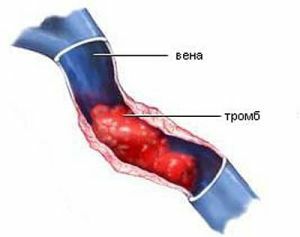
- decrease in blood flow velocity;
- increased blood clotting;
- prolonged immobility - may be due to peculiarities of work, paralysis, etc.;
- violation of the balance of hormones - observed with abortion, pregnancy, the use of hormonal medications, diseases of the endocrine system;
- surgical interventions, traumatic injuries;
- cardiovascular disease - a provoking factor may be heart failure, atherosclerosis, arrhythmia;
- hereditary predisposition.
Types of blood embryos
Thrombi in the legs may have a different nature. Depending on the etiology of the disease,
- is identified as congestive thrombosis;
- inflammatory thrombosis;
- problems due to impaired hematopoiesis.
Depending on the location, thrombosis of the superficial or deep veins may be observed.
Depending on the type of binding of the blood clot and the vessel wall, the following forms are distinguished:
- flotation thrombi;
- parietal clots;
- occlusal emboli;
- mixed types of formations.
Clinical picture
Clots can form in the deep and superficial veins of the legs. At the initial stage of formation of clots in deep veins manifestations may be absent.
As the disease develops, there are symptoms that a thrombus has formed in the vein on the leg:
- sensation of heaviness;
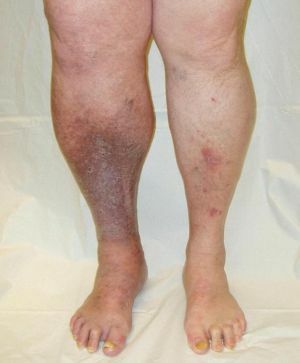
The photo shows thrombi located in the lower part of the foot
- edema;
- blueing of the lower limbs;
- occurrence of raspirating pain;
- febrile state;
- inflammation of the lymph nodes;
- compaction in the affected area.
Progression of the disease often leads to the development of thrombophlebitis - in this case inflammation occurs in the affected vein. In this situation, the temperature increases significantly. If in time to begin treatment, there is a risk of serious complications.
With the defeat of superficial veins located in the subcutaneous tissue, immediately appear symptoms of thrombosis. They may include the following features:
- swelling;
- hyperemia of the affected area;
- strengthening of venous pattern;
- seal;
- pain during movement;
- cramps calf muscles.
Diagnosis of
In order to detect thrombi in the lower extremities, a number of studies have to be carried out. These include the following:
- ultrasound dopplerography;
- ultrasonic duplex angioscanning - this method is considered the most informative;
- rheovasography;
- general blood test - gives little information, allowing to identify only the inflammatory process.
Methods of therapy
Treatment should be selected by a doctor depending on the severity of the disease, the location of the thrombus in a specific part of the leg and other important indicators of the state of veins. In this case, several methods of treatment are used - it can be conservative or surgical.
The first category includes the following:
- minimally invasive procedures;
- use of medicines;
- folk remedies;
- special diet;
- observing the regime of the day.
To achieve good results, experts advise combining several therapies at once. In difficult situations, surgical intervention is indicated.
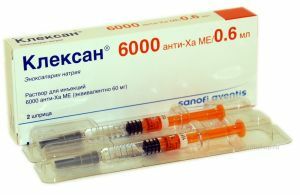 Drug therapy is based on the use of anticoagulants, anti-inflammatory drugs, hemorheological agents, thrombolytic agents.
Drug therapy is based on the use of anticoagulants, anti-inflammatory drugs, hemorheological agents, thrombolytic agents.
To direct anticoagulants include Heparin. With this tool, it is possible to reduce blood clotting, which helps prevent the appearance of new blood clots. In addition, this drug stops the formation of blood clots. The means of the new generation include Clexane, Fragmin and others.
After heparin, the patient is most often prescribed indirect anticoagulants - in particular, Warfarin or Dicumarin. They suppress the formation of thrombi and differ in a long period of application.
Thrombolytic agents are also prescribed to remove thrombus therapeutically. These include Streptokinase, Urokinase. These drugs help to dissolve thrombi, as they affect the fibers of fibrin.
Haemorheological preparations have a positive effect on blood circulation and reduce its viscosity. This category includes such drugs as Refortan, Reosorbilact.
To cope with the pain and eliminate the inflammatory process, the doctor can prescribe anti-inflammatory drugs - for example, Diclofenac or Ketoprofen.
To increase the effectiveness of drug therapy, you need to use additional methods of treatment. Often, minimally invasive procedures are used to control blood clots. In this case, the therapeutic manipulations are performed through a puncture in the vessel. For the procedure, anesthesia is not required.
When detecting a floating thrombus that can move through a blood vessel, special traps are installed - cava filters. They help to prevent the blood clot from getting into important organs - the heart, lungs, etc.
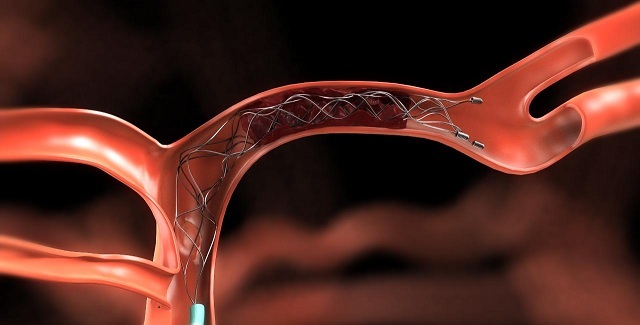
Installation of the cava filter
The following procedures can also be used to treat thrombosis:
- Thrombectomy - this operation is performed to remove the thrombus from the vessel by means of a thin tube;
- operation of Troyanov-Trendelenburg - involves the clamping of a large saphenous vein;
- stenting .
In difficult cases, removal of a fragment of the affected vein is indicated. Such an intervention is carried out under general anesthesia.
In any method of treatment, the patient must necessarily adhere to a strict diet and doctor's recommendations. A person in a hospital is provided with a strict bed rest.
To improve blood circulation, the legs are held on a special platen. To do this is necessary in a raised state. Subsequently, the patient must constantly rewind the affected limb with an elastic bandage or wear compression underwear.
To reduce the viscosity of blood and strengthen the walls of blood vessels, you must adhere to dietary nutrition. It should be built on
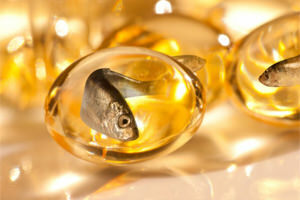
Omega-3 acid - the first product for the dilution of blood
observance of such principles:
- rejection of salty products;
- use of a sufficient amount of liquid;
- consumes a large amount of antioxidants and flavonoids;
- consumes seafood and vegetable fiber.
To speed up the recovery process, it is very important to go in for sports and massage the lower limbs.
Hidden and obvious dangers of
If the timely treatment of thrombosis does not occur, the disease can lead to severe consequences. In rare cases, the occlusal form of the disease provokes the appearance of venous gangrene.
There is also a risk of such complications:
- Painful white reflux - develops due to spasm of arteries, which are located near the thrombosed vein. This condition is very difficult to differentiate with acute violation of the arterial blood circulation.
- Painful blue reflux - in this case, the outflow of blood is almost completely blocked due to the occlusion of the iliac and femoral veins. In this situation, there is a high probability of gangrene development. Purulent melting of a thrombus - with an acute thrombophlebitis an abscess is formed.
- Thromboembolism of the pulmonary artery - accompanied by a violation of breathing and circulation. If small branches overlap, symptoms of hemorrhagic lung infarction appear.
Prevention of thrombosis
Preventive measures are especially relevant for people who have varicose veins, overweight or lead an inadequately active lifestyle.
In order to prevent the development of the disease, it is necessary to carry out such recommendations:
- do for the contrast shower;

- walk barefoot on relief surfaces;
- regularly swim;
- doing cold wiping of the lower limbs;
- make salt baths with cool water;
- perform self-massage of the shins;
- regularly rest, lifting his legs up;
- perform special exercises;
- regularly use compression linen;
- drink at least 2 liters of water per day.
The appearance of blood clots in the legs is a very dangerous condition, posing a real threat to life, therefore the first symptoms of pathology should be the reason for a visit to the doctor. The specialist will conduct a thorough diagnosis and select adequate therapy.
